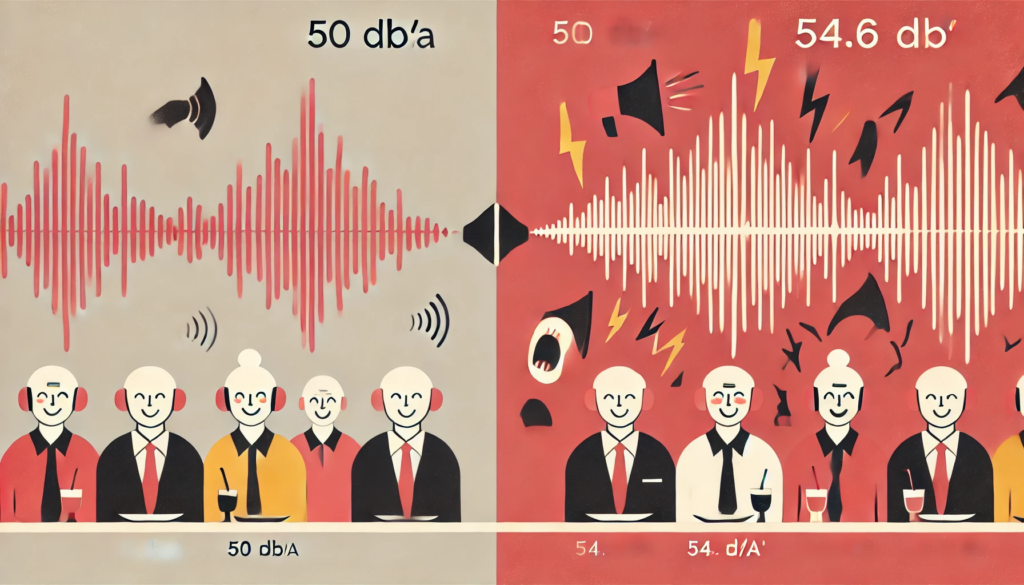
Summary: Impact of Restaurant Noise on Older Adults
🎯 Introduction: Why Restaurant Noise Matters
Restaurants are central to social interaction, offering spaces where people connect over meals. However, the growing trend of minimalistic and open designs has amplified noise levels, creating barriers for effective communication. This study focuses on older adults, particularly those with hearing loss, and explores how restaurant noise affects their ability to communicate, enjoy their dining experience, and willingness to spend time and money.
🔬 Study Overview
Researchers aimed to answer key questions:
1. At what noise level do older adults experience the Lombard Effect (raising vocal effort to overcome noise)?
2. How does perceived communication disturbance correlate with noise?
3. What noise thresholds affect older adults’ willingness to spend time and money?
4. What is the critical noise level at which speech becomes unintelligible for older adults?
Thirty-one participants, aged 60 and older, were categorized by their hearing ability (normal, mild hearing loss, and moderate-to-severe hearing loss). Using a controlled laboratory setup, participants experienced 11 levels of pre-recorded restaurant noise, ranging from 35 dB(A) to 85 dB(A). Various parameters like vocal effort, intelligibility, disturbance, and spending preferences were measured.
📊 Key Results
1. Lombard Effect
The study confirmed that older adults adjust their vocal effort in response to increasing noise. While they exhibit the Lombard Effect, their vocal strain is slightly lower than that of younger adults, likely due to aging vocal cords. Vocal effort increased by 0.51 dB for every 1 dB increase in noise levels above 50 dB(A).
2. Speech Intelligibility
Noise severely impacts the intelligibility of speech, particularly for those with hearing loss. Key findings:
• At 35 dB(A), participants with moderate-to-severe hearing loss could only understand ~50% of words in the absence of visual cues like lip-reading.
• Intelligibility rapidly declined as noise exceeded 51.2 dB(A), with near-total breakdown by 71.3 dB(A).
• Each hearing loss group exhibited different thresholds for intelligibility:
• Normal hearing: 50% intelligibility at 60 dB(A).
• Mild loss: 50% intelligibility at 55 dB(A).
• Moderate-severe loss: 50% intelligibility at 50 dB(A).
3. Perceived Disturbance
Participants reported increasing annoyance as noise levels rose. Key thresholds:
• Perceived disturbance increased dramatically after 51.6 dB(A).
• Disturbance reached a “saturation point” at 66.9 dB(A), after which annoyance stabilized but remained high.
4. Willingness to Spend Time and Money
Noise also influenced participants’ decisions about time and spending:
• Time: Willingness to stay decreased significantly after 65.8 dB(A). Participants expressed a preference to leave quickly when noise levels exceeded this point.
• Money: Spending intentions dropped sharply between 54.6 and 62.0 dB(A), with participants reporting they would spend less than 25% of their budget at higher noise levels.
5. Design Implications
Quieter restaurants were favored by older adults, emphasizing the importance of acoustic capacity (the number of diners a space can accommodate without overwhelming noise).
💡 Insights and Implications
1. Acoustic Design Matters: Restaurants with lower noise levels (below 50 dB(A)) are more inclusive for older adults, fostering better communication and higher customer satisfaction.
2. Economic Impacts: Addressing noise could boost revenue, as quieter environments increase the willingness of older patrons to stay longer and spend more.
3. Age-Friendly Spaces: As the population of adults over 60 grows, businesses must prioritize age-friendly environments. Quieter restaurants with sound-absorbing materials like carpets, curtains, and acoustic panels are key solutions.
4. Lombard Effect Limitations: While older adults do increase vocal effort, their ability to compensate diminishes with noise, leaving them unable to overcome high sound levels.
5. Inclusivity through Accessibility: Noise management in public spaces should be a priority to ensure older adults with hearing loss are not excluded from social experiences.
🛠️ Study Limitations
• Controlled Setting: The study used laboratory simulations, which may not fully replicate real-world conditions like fluctuating noise levels or group conversations.
• Exclusion of Visual Cues: Participants lacked visual aids like lip-reading, which are common in real life.
• Hearing Aids: The study did not account for participants using hearing aids, despite their common use among older adults.
🌟 Recommendations for Restaurants
1. Set Noise Limits: Maintain background noise below 50 dB(A) to ensure optimal communication and customer satisfaction.
2. Use Sound Absorbers: Install carpets, curtains, and acoustic panels to reduce reverberation.
3. Capacity Management: Balance customer seating to avoid exceeding the restaurant’s acoustic capacity.
4. Training for Staff: Educate staff on the importance of acoustics in creating a welcoming environment for all patrons.
🚀 Conclusion
This research highlights the importance of acoustic considerations in restaurant design, particularly for older adults. Reducing background noise can create age-friendly environments, enhancing social experiences, and driving economic benefits for businesses. With an aging population, such measures are not just beneficial—they’re essential for inclusivity.
In-Depth Explanation: The Lombard Effect
The Lombard Effect is a natural and involuntary phenomenon in which speakers increase their vocal effort to maintain speech intelligibility in noisy environments. Named after the French physician Étienne Lombard, who first described it in 1909, this effect has significant implications for communication in settings with high ambient noise, such as restaurants, factories, or crowded public spaces.
How It Works
1. Perception of Noise:
When background noise levels rise, the speaker’s auditory system detects a decline in their own speech clarity. This could be due to ambient sounds, competing voices, or environmental factors that mask their speech.
2. Vocal Adjustment:
To counteract this, the speaker instinctively increases the loudness, pitch, and sometimes the tempo of their voice. This ensures that their speech remains intelligible to listeners despite the competing noise.
3. Physiological Changes:
The effect involves both respiratory and vocal adjustments, such as:
• Increased lung pressure to produce louder sounds.
• Changes in vocal cord tension to adjust pitch.
4. Feedback Loop:
The speaker continuously monitors the effectiveness of their adjustments. If the noise level persists or increases, further vocal effort is applied.
Characteristics of the Lombard Effect
1. Onset Threshold:
• The effect typically begins when noise levels reach around 50 dB(A).
• As noise levels increase, vocal effort intensifies linearly, with a slope of approximately 0.3 to 0.6 dB per dB increase in noise.
2. Changes in Speech:
• Volume: The most noticeable change, as speakers raise their voice.
• Pitch: Speakers may adopt a higher pitch to cut through the noise.
• Articulation: Speech becomes more deliberate, with exaggerated vowel and consonant sounds.
3. Speech Clarity vs. Energy Expenditure:
• While the Lombard Effect helps maintain intelligibility, it can lead to vocal fatigue, especially in prolonged noisy environments.
The Role of Hearing and Age
1. Hearing Sensitivity:
• Individuals with normal hearing can adapt more effectively by fine-tuning their vocal adjustments.
• Those with hearing loss may struggle, as their auditory feedback loop is impaired, leading to less effective compensatory strategies.
2. Age Factors:
• Older adults typically exhibit a lower Lombard Effect compared to younger individuals. This is due to age-related vocal changes, such as reduced lung capacity and vocal cord elasticity, which limit their ability to raise their voice effectively.
Real-World Implications
The Lombard Effect is not just a scientific curiosity; it has real-world applications and consequences:
1. In Restaurants:
• High noise levels force diners to speak louder, exacerbating overall noise.
• Older adults, particularly those with hearing loss, experience greater difficulty communicating, leading to frustration.
2. In Workplaces:
• In noisy industrial settings, employees may rely on the Lombard Effect to communicate, increasing the risk of vocal strain and fatigue.
3. In Public Speaking:
• Speakers in large, noisy venues may unconsciously engage in the Lombard Effect, leading to vocal exhaustion over time.
Mitigation Strategies
1. Acoustic Design:
• Installing sound-absorbing materials like carpets, acoustic panels, and curtains can lower ambient noise, reducing the need for vocal strain.
2. Hearing Aids and Assistive Devices:
• Amplification devices can improve auditory feedback, helping individuals with hearing loss to adapt more effectively.
3. Awareness and Vocal Training:
• Teaching individuals about vocal health and efficient speech techniques can minimize strain in noisy settings.
Conclusion
The Lombard Effect highlights the interplay between human communication and environmental factors. While it is a useful adaptive mechanism for maintaining intelligibility, it can have negative effects on vocal health and overall communication efficiency in noisy environments. Understanding and addressing the causes of the Lombard Effect, particularly in public and social spaces, can lead to better experiences for everyone.

FAQs: Restaurant Noise and Its Impact on Older Adults
Q1: What is the Lombard Effect, and how does it relate to restaurant noise?
The Lombard Effect is the involuntary tendency to raise one’s voice in noisy environments to maintain speech intelligibility. In restaurants, background noise above 50 dB(A) triggers this effect in older adults, increasing their vocal strain and making communication more challenging.
Q2: How does restaurant noise impact older adults with hearing loss?
Noise levels above 50 dB(A) significantly reduce speech intelligibility for older adults, especially those with hearing loss. For individuals with moderate-to-severe hearing loss, intelligibility can drop to 50% even at lower noise levels (50 dB(A)), making conversations difficult.
Q3: At what noise level do older adults start feeling disturbed in restaurants?
Older adults report noticeable communication disturbances starting at 51.6 dB(A). Disturbance levels increase dramatically until they stabilize around 66.9 dB(A).
Q4: How does noise influence the time older adults are willing to stay in restaurants?
Older adults are less likely to stay in restaurants with noise levels above 65.8 dB(A). At this point, they express a preference to leave quickly due to discomfort caused by high noise levels.
Q5: How does noise affect older adults’ willingness to spend money in restaurants?
Spending intentions decline significantly between 54.6 and 62.0 dB(A). Beyond 62 dB(A), participants indicated they would spend less than 25% of their intended budget, showing the economic impact of excessive noise.
Q6: What are the key noise thresholds identified in the study?
• 51.6 dB(A): Significant increase in perceived disturbance.
• 54.6 dB(A): Sharp decline in willingness to spend money.
• 65.8 dB(A): Decrease in willingness to spend time in the restaurant.
Q7: What design solutions can restaurants implement to reduce noise?
Restaurants can use sound-absorbing materials like carpets, curtains, and acoustic panels to lower noise levels. Managing the acoustic capacity (number of diners within a space that maintains optimal noise levels) is also critical.
Q8: Why are older adults more sensitive to noise compared to younger adults?
Older adults often experience age-related hearing loss, reduced cognitive auditory processing, and decreased tolerance to loud environments. These factors make them more sensitive to noise and its impact on communication.
Q9: How can restaurants become more age-friendly?
By maintaining noise levels below 50 dB(A), using sound-absorbing materials, and designing spaces with appropriate acoustic capacity, restaurants can create environments that support communication and inclusivity for older adults.
Q10: What are the economic benefits of reducing restaurant noise?
Quieter environments encourage older adults to stay longer and spend more money, potentially increasing revenue. Ensuring a comfortable acoustic setting can attract a loyal customer base among older adults.
Q11: Does the study account for the use of hearing aids?
No, participants did not use hearing aids during the study, even though some were daily users. This limitation reflects the reality that many older adults with hearing loss do not consistently use hearing aids.
Q12: What is the significance of the study for the hospitality industry?
The study highlights the need for restaurants to prioritize acoustic design. By addressing noise levels, businesses can improve customer satisfaction, increase inclusivity, and boost economic returns from older patrons.

